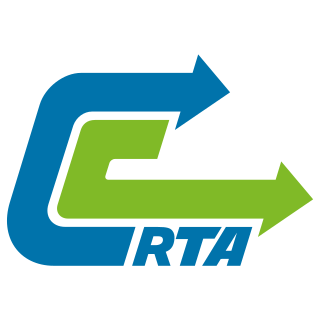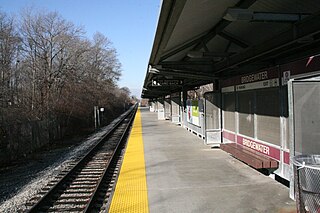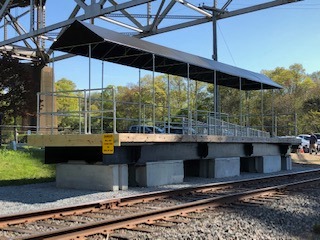
Wareham is a town in Plymouth County, Massachusetts, United States. As of the 2022 census, the town had a population of 23,303.

Bourne is a town in Barnstable County, Massachusetts, United States. The population was 20,452 at the 2020 census.

Sandwich is a town in Barnstable County, Massachusetts and is the oldest town on Cape Cod. The town motto is Post tot Naufracia Portus, "after so many shipwrecks, a haven". The population was 20,259 at the 2020 census.

The MBTA Commuter Rail system serves as the commuter rail arm of the Massachusetts Bay Transportation Authority's (MBTA's) transportation coverage of Greater Boston in the United States. Trains run over 394 mi (634 km) of track to 134 stations. It is operated under contract by Keolis, which took over operations on July 1, 2014, from the Massachusetts Bay Commuter Railroad Company (MBCR).

The Old Colony Railroad (OC) was a major railroad system, mainly covering southeastern Massachusetts and parts of Rhode Island, which operated from 1845 to 1893. Old Colony trains ran from Boston to points such as Plymouth, Fall River, New Bedford, Newport, Providence, Fitchburg, Lowell and Cape Cod. For many years the Old Colony Railroad Company also operated steamboat and ferry lines, including those of the Fall River Line with express train service from Boston to its wharf in Fall River where passengers boarded luxury liners to New York City. The company also briefly operated a railroad line on Martha's Vineyard, as well as the freight-only Union Freight Railroad in Boston. The OC was named after the "Old Colony", the nickname for the Plymouth Colony.

The Cape Cod Railroad is a railroad in southeastern Massachusetts, running from Pilgrim Junction in Middleborough across the Cape Cod Canal Railroad Bridge, where it splits towards Hyannis in one direction and Falmouth in the other. It was incorporated in 1846 as the Cape Cod Branch Railroad to provide a rail link from the Fall River Railroad line in Middleborough to Cape Cod.

Braintree station is an intermodal transit station in Braintree, Massachusetts. It serves the MBTA's Red Line and the MBTA Commuter Rail Old Colony Lines as well as MBTA buses.

The Cape Codder was a seasonal passenger train operated by Amtrak between New York City and Hyannis, Massachusetts, on Cape Cod. It operated during the summer between 1986 and 1996. It was the first regular service from New York to the Cape since 1964. The New York, New Haven and Hartford Railroad previously had operated a train under this name until 1958.

Cape Cod Regional Transit Authority (CCRTA) operates a bus transit system of fixed and flexible routes, seasonal rail service to Boston, and a paratransit service in the Cape Cod region of Massachusetts. The CCRTA was created under the provisions of Chapter 161B of the Massachusetts General Laws in 1976. Its main hub and base of operations is the Hyannis Transportation Center on Main Street in Hyannis, Massachusetts.

The Old Colony Lines are a pair of branches of the MBTA Commuter Rail system, connecting downtown Boston, Massachusetts with the South Shore and cranberry-farming country to the south and southeast. The two branches operate concurrently for 10 miles (16 km) via the Old Colony Mainline from South Station to Braintree station. The Middleborough/Lakeville Line then winds south through Holbrook, Brockton, Bridgewater, Middleborough, and Lakeville via the Middleborough Main Line and Cape Main Line. The Kingston Line heads southeast to serve Weymouth, Abington, Whitman, Hanson, Halifax, and Kingston by way of the Plymouth branch. Limited service to Plymouth was provided prior to April 2021 but was cut due to low ridership and budget constraints. The Greenbush Line, which was also part of the Old Colony Division, was reactivated in 2007 as a separate project.

The Middleboro Secondary is a railroad line owned by MassDOT in the U.S. state of Massachusetts. The line runs from Attleboro to Middleborough via Taunton.

Attleboro station is a commuter rail station on the MBTA's Providence/Stoughton Line located in Attleboro, Massachusetts. By a 2018 count, Attleboro had 1,547 daily riders, making it the fourth busiest station on the system outside Boston.

Brockton station is an MBTA Commuter Rail station in Brockton, Massachusetts. It serves the MBTA Middleborough/Lakeville Line and is a stop on the seasonal CapeFLYER service. The station has a single accessible full-length high-level platform that serves the line's two tracks. It is located adjacent to the BAT Centre, the primary hub for Brockton Area Transit Authority local bus service.

Bridgewater station is an MBTA Commuter Rail station in Bridgewater, Massachusetts, served by the Middleborough/Lakeville Line. It is located on the east end of the Bridgewater State University campus along the Middleborough Main Line.

Middleborough/Lakeville station is an MBTA Commuter Rail station in Lakeville, Massachusetts, just south of the Middleborough border. It is the southern terminus of the Middleborough/Lakeville Line; it is also an intermediate stop for seasonal CapeFlyer service to Cape Cod. Middleborough/Lakeville has a single full-length high-level side platform serving the line's single track.

Buzzards Bay station is a train station located on Main Street in Buzzards Bay, Massachusetts. The site also contains an interlocking tower. The Cape Cod Canal Railroad Bridge is adjacent.
The Cape Cod & Hyannis Railroad was a railroad that provided tourist and seasonal passenger services in Southeastern Massachusetts in the 1980s. Its primary service operated from the Braintree MBTA station to Hyannis on Cape Cod; branches to Attleboro and Falmouth also operated in some years. The service ended after the 1988 summer season amid early-1989 state budget cuts in Massachusetts; much of the same trackage is being used for the seasonal CapeFLYER service.

Wareham Village station is a train station that is located on Merchants Way in Wareham, Massachusetts. Service to Wareham formerly ran from 1848 until 1959. A shelter, built in 1985 for short-lived Amtrak and commuter service, is currently unused. A new platform constructed nearby for the CapeFLYER summer weekend service opened for the CapeFLYER on June 27, 2014.

Bourne station is a train station in Bourne, Massachusetts, served by the CapeFlyer.

Middleborough station is an under-construction MBTA Commuter Rail station in Middleborough, Massachusetts. It is expected to open in mid-2024 as part of the South Coast Rail project, replacing Middleborough/Lakeville station for regular service. The station will have a single side platform located inside the wye between the Middleborough Main Line and the Middleboro Secondary.





























